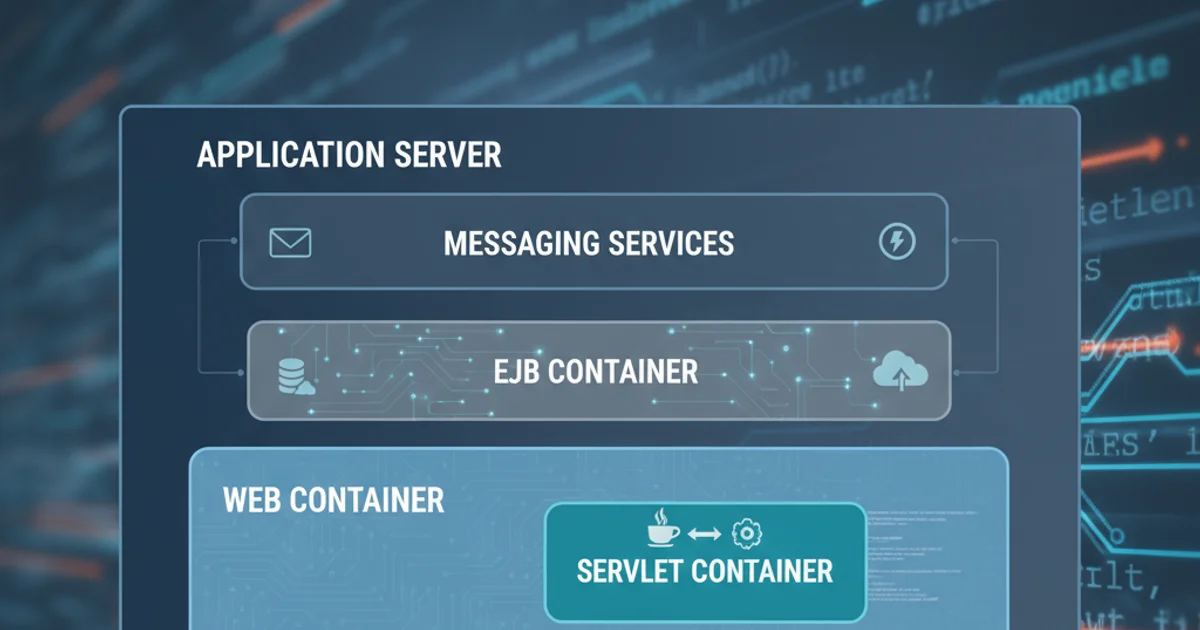What is the difference between an application server and a servlet container?
Categories:
Application Server vs. Servlet Container: Understanding the Core Differences

Explore the fundamental distinctions between application servers and servlet containers, their functionalities, and when to use each in Java/Jakarta EE development.
In the world of Java and Jakarta EE development, the terms "application server" and "servlet container" are frequently used, often interchangeably, leading to confusion. While a servlet container is a core component of an application server, they are not the same. Understanding their distinct roles and capabilities is crucial for designing and deploying robust enterprise applications. This article will clarify these differences, providing insights into their architecture, features, and typical use cases.
What is a Servlet Container?
A servlet container, also known as a web container, is a specialized component that manages the lifecycle of Java Servlets and JavaServer Pages (JSPs). It provides the runtime environment for web components, handling HTTP requests and responses, session management, security, and other web-related functionalities. The primary responsibility of a servlet container is to parse incoming HTTP requests, map them to the appropriate servlet, invoke the servlet's methods (e.g., doGet(), doPost()), and send the generated response back to the client. It implements the Java Servlet API and JSP specifications.
Popular examples of standalone servlet containers include Apache Tomcat, Jetty, and Undertow. These are often sufficient for web applications that primarily serve dynamic web content and do not require advanced enterprise features like distributed transactions, message queues, or Enterprise JavaBeans (EJBs).
flowchart TD
A[Client Browser] --> B{HTTP Request}
B --> C["Servlet Container (e.g., Tomcat)"]
C --> D["Servlet Lifecycle Management"]
D --> E["Servlet (e.g., MyServlet)"]
E --> F["Business Logic / Data Access"]
F --> E
E --> D
D --> C
C --> G{HTTP Response}
G --> ASimplified flow of an HTTP request through a Servlet Container
What is an Application Server?
An application server, in the context of Jakarta EE (formerly Java EE), is a comprehensive platform that provides a full range of services for developing and deploying enterprise-level applications. It encompasses a servlet container and extends its capabilities with additional services defined by the Jakarta EE specifications. These services include, but are not limited to:
- EJB Container: Manages Enterprise JavaBeans (EJBs) for distributed transaction management, security, and concurrency.
- JMS (Java Message Service): Provides asynchronous messaging capabilities for reliable communication between applications.
- JTA (Java Transaction API): Supports distributed transactions across multiple resources.
- JNDI (Java Naming and Directory Interface): A unified interface for accessing naming and directory services.
- Connectors (JCA): Integrates with enterprise information systems (EIS) like databases, ERPs, and mainframes.
- Security Services: Comprehensive security infrastructure for authentication and authorization.
Application servers are designed for complex, mission-critical applications that require high scalability, reliability, and integration with various enterprise systems. Examples include WildFly (formerly JBoss AS), GlassFish, IBM WebSphere Application Server, and Oracle WebLogic Server.
flowchart LR
subgraph Application Server
A["Servlet Container (Web Profile)"]
B["EJB Container"]
C["JMS Provider"]
D["JTA Manager"]
E["JNDI Service"]
F["JCA Connectors"]
end
Client --> A
A -- "Web Components (Servlets, JSPs)" --> B
B -- "Business Logic (EJBs)" --> C
B -- "Transactions" --> D
A -- "Resource Lookup" --> E
B -- "EIS Integration" --> F
C -- "Asynchronous Messaging" --> OtherSystems["Other Systems"]Components and interactions within a Jakarta EE Application Server
Key Differences Summarized
The primary distinction lies in their scope and the range of services they offer. A servlet container is focused on web-tier components, while an application server provides a complete enterprise-grade runtime environment.
| Feature | Servlet Container (e.g., Tomcat) | Application Server (e.g., WildFly) |
|---|---|---|
| Primary Role | Web component runtime | Full enterprise platform |
| Specifications | Servlet API, JSP, WebSocket | Full Jakarta EE (EJB, JMS, JTA, etc.) |
| Components | Servlets, JSPs, Filters, Listeners | All web components + EJBs, MDBs, etc. |
| Transactions | Local (JDBC) | Distributed (JTA) |
| Messaging | No built-in JMS | Built-in JMS provider |
| Resource Mgmt. | Basic connection pooling | Advanced connection pooling, JCA |
| Complexity | Lower | Higher |
| Memory Footprint | Smaller | Larger |
| Use Cases | Simple web apps, REST APIs | Complex enterprise apps, microservices with full EE features |
When to Choose Which?
The choice between a servlet container and a full application server depends heavily on the requirements of your application:
Choose a Servlet Container (e.g., Tomcat) if:
- Your application is primarily a web application serving dynamic content or RESTful APIs.
- You don't need distributed transactions, EJBs, or integrated messaging services.
- You prefer a lightweight, fast-starting environment.
- You want fine-grained control over your dependencies and don't want the overhead of a full EE stack.
Choose an Application Server (e.g., WildFly, GlassFish) if:
- Your application requires robust enterprise features like distributed transactions, message-driven beans (MDBs), or remote EJBs.
- You need seamless integration with various enterprise information systems (EIS).
- You are building a large-scale, mission-critical application that benefits from the standardized services and managed environment of Jakarta EE.
- You prefer a platform that handles many infrastructure concerns out-of-the-box, allowing developers to focus more on business logic.
In conclusion, while a servlet container is the engine that drives web applications in Java, an application server is a complete ecosystem built around that engine, offering a rich set of services for complex enterprise development. Understanding this distinction empowers developers to make informed architectural decisions, leading to more efficient and scalable applications.